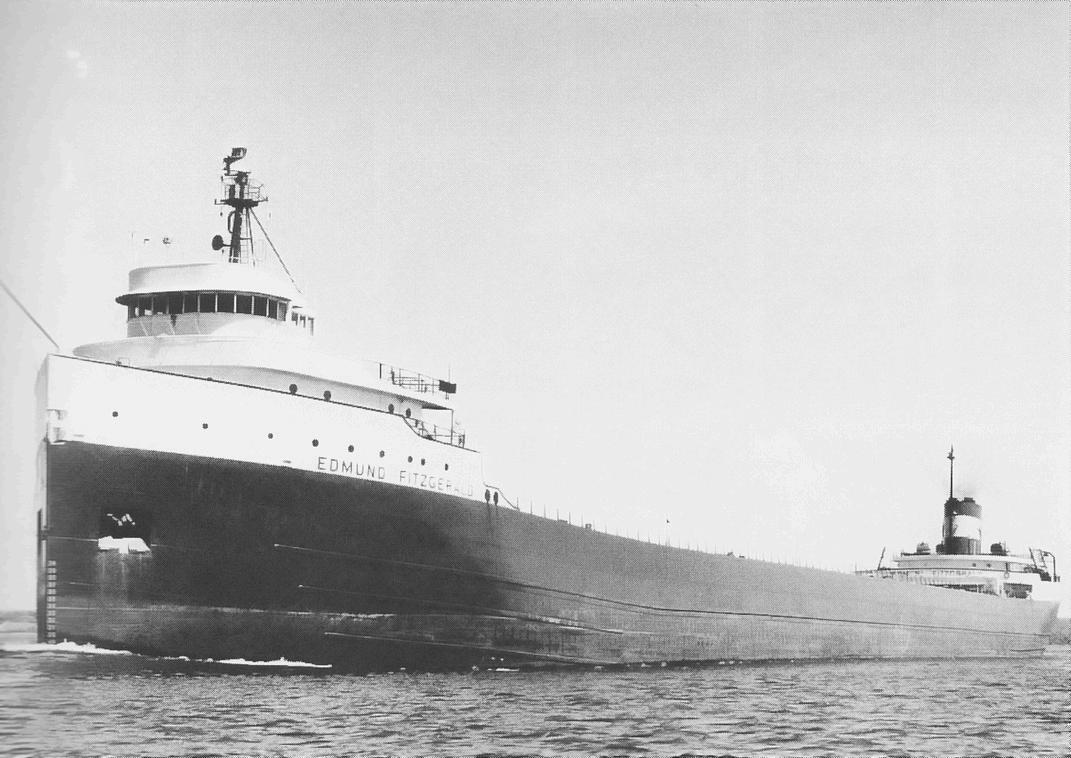
4 minute read
BITTER END
by theensign
A legendary maritime tragedy: SS Edmund Fitzgerald
BY ROBERT A. BUCHANAN
The sinking of the SS Edmund Fitzgerald remains one of the most haunting maritime tragedies in Great Lakes history The ship, a titan of the freshwater seas, met its untimely fate 50 years ago, on Nov. 10, 1975, in the frigid waters of Lake Superior. Immortalized in art and song, this event continues to capture the imagination for its mystery and its impact on maritime safety.
The Edmund Fitzgerald was launched in 1958 and was the largest freighter on the Great Lakes at the time. Measuring 729 feet, the vessel was a towering presence, designed to transport taconite iron ore from Duluth, Minnesota, mines to iron works in Detroit and other Great Lakes ports.
The fateful journey began on Nov 9, 1975, when the Edmund Fitzgerald departed from Superior, Wisconsin, bound for a steel mill near Detroit Capt Ernest M McSorley, a veteran with over 40 years of maritime experience, was at the helm. Loaded with 26,116 tons of taconite pellets, the ship was being followed by U.S. Steel Corp.’s Arthur M. Anderson under the command of Capt. Bernie Cooper.
As the Edmund Fitzgerald sailed into Lake Superior, weather conditions began to deteriorate rapidly. The National Weather Service had issued gale warnings, which soon escalated to a full storm warning, predicting winds of up to 50 knots and waves reaching heights of 16 feet. Despite the severe weather the Edmund Fitzgerald pressed on, maintaining radio contact with Cooper on the Anderson. McSorley and Cooper agreed to take the northerly course across Lake Superior protected the Canadian shore
By the afternoon of Nov. 10, the storm had reached its peak. The Edmund Fitzgerald reported that it had encountered heavy seas and was listing due to water entering the ship. McSorley radioed the Anderson, indicating that the ship had lost its radar and was taking on water. Despite these problems, McSorley reported that they were holding their own, although he knew he had a damaged ship. At approximately 7:10 pm, the Anderson lost radar contact with the Edmund Fitzgerald. Moments later, the ship vanished, plunging to the bottom of the lake without a distress signal.
Since the Soo Locks first opened in 1855, wreckages have cluttered the bottoms of the Great Lakes, most often occurring during the gales of November. But the Edmund Fitzgerald was a large, modern, powerful vessel that simply disappeared without issuing a mayday call or any other sign of distress. McSorley was a skilled, experienced mariner who knew the waters of the lakes thoroughly. The crew of 29, all experienced sailors, also disappeared without a trace.
Subsequently, the wreck site has been located by sonar and photographed by an underwater camera. The Canadian government has declared the wreck site “hallowed ground.”
The National Transportation Safety Board conducted a detailed investigation but could not reach a unanimous decision about the cause of the sinking. The board stated that the hatch covers were not watertight, so they allowed water to enter the hold, resulting in massive flooding. But would McSorley, one of the best captains on the lakes, navigate into a storm with questionable hatch covers when he knew trouble could be ahead? Alternatively, Cooper of the Anderson and his watch officer were adamant that the Edmund Fitzgerald had crossed over Six Fathom Shoal and struck bottom. But could the damaged Edmund Fitzgerald continue onward with a ruptured hull? Finally, Capt Dudley Paquette on the following Wilfred Sykes wrote that a massive rogue wave could have caused the Edmund Fitzgerald’s demise.
Today, the loss of the Edmund Fitzgerald remains a mystery. Stand on the shore at Whitefish Point, only 17 miles from the wreckage site, on a warm, calm day and look north across Lake Superior to imagine the scene on Nov. 10, 1975. Hear the somber voice of McSorley enter the wheelhouse of the Anderson loud and clear: “We are holding our own.”








